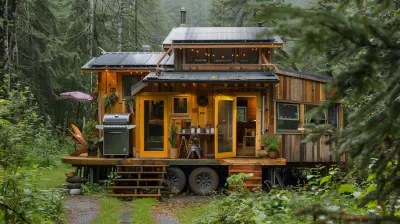The Role of Green Technology in Fighting Climate Change
18 January 2025
Climate change is no longer a distant problem we can put off for another day. It’s knocking on our door right now, and the world is feeling the heat—literally. Rising temperatures, melting ice caps, and extreme weather events are becoming more common by the day. It’s no longer a question of whether we should act; it’s a question of what we should be doing, now. This is where green technology steps up to the plate.
But what exactly is green technology? How does it fit into the fight against climate change? And why does it play such a crucial role? Let’s dive into this topic and see how technology is helping us tackle one of the greatest challenges of our time.

What is Green Technology?
Let’s start with the basics. Green technology, often referred to as "clean tech," is all about developing technology that has a minimal environmental footprint. It’s technology designed to conserve natural resources, reduce emissions, and promote sustainability. Think renewable energy, electric vehicles, energy-efficient appliances, and even innovations like carbon capture.In a world where our carbon footprint is growing by the second, green tech is like the superhero we didn’t know we needed—but desperately do. It’s the science that can help reverse the damage we've done to our planet and shift us toward a more sustainable future.
Why Is Green Technology Important?
You might be wondering, "Why is green technology such a big deal?" Well, consider this: most of the world's energy still comes from burning fossil fuels like coal, oil, and natural gas. These sources release tons of carbon dioxide (CO2) into the atmosphere, which is the primary driver of global warming. Green technology offers alternatives that produce little to no CO2, helping to slow down the rate at which the planet is heating up.It’s not just about energy, either. Green tech spans across industries, from agriculture to transportation to manufacturing. It’s making those industries cleaner and more efficient, which is essential if we want to reduce our overall environmental impact.

Renewable Energy: The Foundation of Green Technology
When people think of green technology, renewable energy is usually the first thing that comes to mind—and for good reason. Renewable energy sources like solar, wind, and hydropower are the backbone of any sustainable future. Unlike fossil fuels, these sources won’t run out anytime soon, and they produce little to no emissions.Solar Power
Solar energy is one of the most well-known forms of renewable energy. It involves capturing sunlight and converting it into electricity using solar panels. What’s great about solar power is that it’s abundant—there’s enough sunlight hitting the Earth every hour to power the world’s energy needs for an entire year!Plus, the cost of solar technology has plummeted over the last decade, making it more accessible to homeowners, businesses, and even large corporations. Every rooftop solar panel installed is a step toward a cleaner, greener future.
Wind Power
Wind turbines harness the power of the wind to generate electricity. While you may have seen those tall, white windmills dotting the countryside, they’re more than just pretty scenery. Wind energy has become one of the fastest-growing renewable energy sources worldwide. It’s clean, it’s efficient, and like solar power, it’s becoming more affordable.However, there’s one catch: you need the wind to blow. While that’s not an issue in many locations, it can be a limiting factor in areas with little wind.
Hydropower
Hydroelectric power is another key player in the renewable energy game. It uses the flow of water to generate electricity, typically from dams. Hydropower is extremely efficient and reliable, but it can have its downsides—like disrupting local ecosystems. Still, it remains a significant source of clean energy worldwide.
Electric Vehicles: Driving Us Toward a Sustainable Future
Let’s face it: cars have been a big part of the problem when it comes to climate change. The transportation sector is one of the largest contributors to greenhouse gas emissions, largely because we’ve been so reliant on gas-guzzling, emissions-spewing vehicles. Enter electric vehicles (EVs), the game-changer we’ve all been waiting for.The Rise of Electric Vehicles
Electric vehicles are powered by electricity rather than gasoline or diesel, meaning they produce zero emissions from the tailpipe. No more CO2, no more harmful pollutants, just clean, quiet driving. And thanks to advances in battery technology, EVs are becoming more practical for everyday use, with longer ranges and shorter charging times.Major automakers are hopping on the EV bandwagon, and governments around the world are offering incentives to encourage people to make the switch. The future of transportation is electric, and it’s going to play a massive role in reducing our overall carbon footprint.
Charging Infrastructure
Of course, if we want people to adopt EVs, we need the infrastructure to support them. That’s where public charging stations come in. More and more cities are investing in electric vehicle charging networks, making it easier than ever to own an EV without worrying about running out of juice on the road.The Impact of EVs on Climate Change
Switching to electric vehicles could drastically reduce emissions in the transportation sector. According to some estimates, widespread adoption of EVs could cut global carbon emissions by as much as 1.5 gigatons annually by 2030. That’s the equivalent of taking hundreds of millions of gas-powered cars off the road!
Energy Efficiency: Doing More With Less
When we talk about green technology, it’s not just about creating new sources of clean energy—it’s also about using the energy we do have more efficiently. Energy efficiency is all about getting the same (or better) performance while using less energy.Smart Homes and Appliances
Ever heard of a smart home? It’s not just a cool way to impress your friends—it’s also a key part of energy efficiency. Smart thermostats, for example, learn your habits and adjust the temperature in your home accordingly, reducing energy waste. Energy-efficient appliances like refrigerators, dishwashers, and washing machines use less electricity to get the job done, saving both energy and money.LED Lighting
Another simple yet effective way to boost energy efficiency is by switching to LED lights. LED bulbs use up to 75% less energy than traditional incandescent bulbs, and they last much longer. It’s a small change that can make a big difference over time.Insulation and Building Materials
In addition to gadgets and appliances, energy efficiency also extends to the materials we use to build our homes and workplaces. Better insulation means less energy is needed to heat or cool a building, cutting down on both emissions and energy costs.Carbon Capture Technology: Cleaning Up Our Mess
What if we could actually remove carbon dioxide from the atmosphere? That’s the promise of carbon capture technology. While it may sound like science fiction, it’s already being developed and implemented in some areas.How Does Carbon Capture Work?
Carbon capture technology involves trapping carbon dioxide emissions before they’re released into the atmosphere, or extracting CO2 that’s already out there. The captured carbon can then be stored underground or even used in industrial processes.The Potential of Carbon Capture
Carbon capture could be a game-changer in the fight against climate change, especially for industries that are hard to decarbonize, like cement and steel production. While it’s not a silver bullet, it could be a valuable tool in our climate toolbox.
The Challenges of Green Technology
While green technology offers plenty of promise, it’s not without its challenges. For one, there’s the issue of cost. While renewable energy and electric vehicles are becoming more affordable, they still require significant upfront investments. In many parts of the world, people simply don’t have the means to make the switch.Then there’s the issue of scale. Green technology needs to be adopted on a massive scale if we’re going to make a real dent in global emissions. That’s where policy comes in. Governments need to invest in green tech, provide incentives for adoption, and set regulations that encourage or even require the use of cleaner technology.
The Road Ahead: A Green Future?
So, where do we go from here? The good news is that progress is being made. Renewable energy is on the rise, EVs are becoming more common, and innovations in energy efficiency and carbon capture are gaining traction. But we’re not out of the woods yet.If we want to seriously combat climate change, we need to ramp up our efforts. That means making green technology more accessible, investing in research and development, and pushing for policies that prioritize sustainability.
Ultimately, the role of green technology in fighting climate change is huge. It’s not just part of the solution—it’s the engine driving the solution forward. The sooner we embrace it, the better off our planet will be.
all images in this post were generated using AI tools
Category:
Green TechnologyAuthor:

Michael Robinson
Discussion
rate this article
21 comments
Reece Vasquez
Thank you for this insightful article on green technology's impact on climate change. It's encouraging to see innovative solutions being highlighted. I look forward to seeing how these technologies can transform our approach to sustainability.
February 16, 2025 at 12:07 PM

Michael Robinson
Thank you for your kind words! I'm glad you found the article insightful and share your enthusiasm for the potential of green technology in promoting sustainability.
Tatianna McAllister
Green tech isn't just a trend; it's our lifeline. Embracing innovation today paves the way for a sustainable tomorrow. Let's turn eco-solutions into global solutions—because Earth won't save itself.
February 4, 2025 at 4:42 AM

Michael Robinson
Absolutely! Green technology is essential for our survival and a key driver of sustainable progress. Together, we can transform eco-innovations into impactful global solutions.
Isabelle Sheppard
Green technology is essential for sustainable development, enabling innovation that reduces carbon footprints while fostering economic growth and environmental resilience.
January 29, 2025 at 8:06 PM

Michael Robinson
Thank you for your insightful comment! I completely agree that green technology plays a crucial role in achieving sustainable development and addressing climate change.
Susan McHugh
Great article! It’s inspiring to see how green technology can play a crucial role in combating climate change. Every innovative solution brings us one step closer to a sustainable future. Let’s continue to support and invest in these advancements for a healthier planet for generations to come. Keep up the fantastic work!
January 27, 2025 at 4:03 AM

Michael Robinson
Thank you for your kind words! I'm glad you found the article inspiring. Together, we can make a difference with green technology!
Amy Phillips
Great read! It's inspiring to see how green technology is paving the way for a more sustainable future. It’s not just about saving the planet but also about creating innovative solutions that improve our daily lives. Every small step counts—together, we can make a big difference! 🌍✨
January 26, 2025 at 12:00 PM

Michael Robinson
Thank you! I'm glad you found it inspiring. Every step towards green technology is indeed a step towards a brighter, more sustainable future! 🌱
Geneva Hernandez
Green technology is pivotal in combating climate change by reducing carbon footprints, enhancing energy efficiency, and promoting sustainable practices. Its integration across industries fosters innovation and drives a transition towards a greener economy.
January 26, 2025 at 4:03 AM

Michael Robinson
Thank you for your insightful comment! I completely agree that green technology is essential for reducing our carbon footprint and fostering sustainability across various industries.
Noelle McNulty
Exciting to see technology leading the charge for a greener future!
January 24, 2025 at 9:50 PM

Michael Robinson
Thank you! Technology indeed plays a crucial role in driving sustainable solutions for our planet.
Aisha McDaniel
Nature's tech, future bright.
January 23, 2025 at 9:34 PM

Michael Robinson
Thank you! Indeed, harnessing nature's innovations is key to a sustainable future.
Makayla Flores
Great insight! Embracing green technology is crucial for a sustainable future. Let’s support innovation for a healthier planet!
January 23, 2025 at 4:00 AM

Michael Robinson
Thank you! I completely agree—innovation in green technology is essential for achieving a sustainable future. Your support is vital!
Niva Hahn
Green tech: because saving the planet shouldn't be an optional extra!
January 22, 2025 at 9:19 PM

Michael Robinson
Absolutely! Green technology is essential for sustainable progress and must be prioritized to combat climate change effectively.
Elin Hodge
Embrace green tech for a sustainable future!
January 22, 2025 at 3:38 AM

Michael Robinson
Absolutely! Embracing green tech is crucial for reducing emissions and fostering a sustainable future.
Alyssa Shaffer
Green technology is essential, but innovation must prioritize accessibility and equity.
January 21, 2025 at 9:34 PM

Michael Robinson
Absolutely! Ensuring that green technology is accessible and equitable is vital for effective climate action, as it empowers all communities to participate in and benefit from sustainable solutions.
Brooke Webster
Embracing green technology is not just a choice; it's a necessity for a sustainable future. Together, we can harness innovation to combat climate change and create a healthier planet for generations to come!
January 21, 2025 at 1:55 PM

Michael Robinson
Absolutely! Embracing green technology is essential for mitigating climate change and ensuring a sustainable future. Together, innovation can lead the way to a healthier planet.
Renata McGinn
Great insights! Emphasizing renewable energy sources and innovative tech solutions will be key to effectively combatting climate change.
January 21, 2025 at 3:35 AM

Michael Robinson
Thank you! I completely agree—renewable energy and innovative technologies are crucial for a sustainable future.
Ranger Pope
Green tech: saving the planet, one gadget at a time!
January 20, 2025 at 9:45 PM

Michael Robinson
Absolutely! Every innovative green gadget contributes to a more sustainable future, helping us reduce our carbon footprint and combat climate change effectively.
Arianth McCabe
Great article on the vital role of green technology in combating climate change! It's encouraging to see innovative solutions being prioritized. As we advance, collaboration among governments, businesses, and individuals will be crucial in maximizing the potential of these technologies. Looking forward to seeing more developments in this essential field!
January 19, 2025 at 7:23 PM

Michael Robinson
Thank you for your insightful comment! I completely agree that collaboration is key to unlocking the full potential of green technology in the fight against climate change. Together, we can drive meaningful change!
Kenna Young
This article effectively highlights the crucial role green technology plays in combating climate change. It's essential that we not only embrace these innovations but also advocate for their widespread adoption to ensure a sustainable future.
January 19, 2025 at 1:20 PM

Michael Robinson
Thank you for your insightful comment! I completely agree that embracing and advocating for green technology is vital for a sustainable future.
Heidi Acevedo
Great article! It's inspiring to see how green technology can make a real difference. Every small step counts in the fight against climate change—let's keep pushing forward!
January 19, 2025 at 3:48 AM

Michael Robinson
Thank you! I completely agree—every effort matters in our journey towards a sustainable future. Let’s continue to innovate and inspire change together!
Kassidy Whitaker
Green technology: where solar panels get a sunbath and wind turbines do the cha-cha! Let’s power up for a sustainable future—because Mother Earth deserves a dance party too! 🌍💃
January 18, 2025 at 7:54 PM

Michael Robinson
Absolutely! Green technology is indeed the life of the party in our fight against climate change—energizing our planet while keeping it groovy and sustainable! Let’s keep the momentum going! 🌱✨
Zadie McCoy
As we delve into the uncharted realms of green technology, whispers of a transformative revolution emerge. Could these innovations hold the key to unraveling the intricate dance between humanity and nature? Join us in exploring the concealed mysteries and potential awakenings that could redefine our future in the fight against climate change.
January 18, 2025 at 11:49 AM

Michael Robinson
Absolutely! Green technology is pivotal in harmonizing our relationship with nature and addressing climate change, unlocking new pathways for a sustainable future.
Imani Brown
Great article! It's inspiring to see how green technology is paving the way for a sustainable future. Every innovation brings us closer to combating climate change and creating a healthier planet for future generations.
January 18, 2025 at 3:56 AM

Michael Robinson
Thank you! I'm glad you found the article inspiring. Indeed, green technology is crucial for a sustainable future and combating climate change.
MORE POSTS

The Intersection of Blockchain and Renewable Energy Trading

How Blockchain is Changing the Face of Crowdfunding

Noise-Canceling Headphones: A Jetsetter's Best Friend

Off-Grid Solar Systems: A Step Toward Energy Independence

Boost Your Creativity with These Top Digital Tools

The Importance of Strategic Partnerships for Tech Startups

Time-Saving Travel Gadgets for the Busy Professional

The Role of Government in Enforcing Cybersecurity Regulations

Battle of the Tablets: Which One Is Worth Your Investment?

How to Use Tech to Plan the Perfect Trip

Smart Backpacks: The Future of Travel and Tech Storage

The Role of Big Data in Enhancing Customer Retention

Personalized Robots: Tailoring Machines to Your Needs